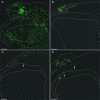Olfactory ensheathing cells (OECs) and the treatment of CNS injury: advantages and possible caveats
- PMID: 14690478
- PMCID: PMC1571239
- DOI: 10.1111/j.1469-7580.2004.00257.x
Olfactory ensheathing cells (OECs) and the treatment of CNS injury: advantages and possible caveats
Abstract
One of the main research strategies to improve treatment for spinal cord injury involves the use of cell transplantation. This review looks at the advantages and possible caveats of using glial cells from the olfactory system in transplant-mediated repair. These glial cells, termed olfactory ensheathing cells (OECs), ensheath the axons of the olfactory receptor neurons. The primary olfactory system is an unusual tissue in that it can support neurogenesis throughout life. In addition, newly generated olfactory receptor neurons are able to grow into the CNS environment of the olfactory bulb tissue and reform synapses. It is thought that this unique regenerative property depends in part on the presence of OECs. OECs share some of the properties of both astrocytes and Schwann cells but appear to have advantages over these and other glial cells for CNS repair. In particular, OECs are less likely to induce hypertrophy of CNS astrocytes. As well as remyelinating demyelinated axons, OEC grafts appear to promote the restoration of functions lost following a spinal cord lesion. However, much of the evidence for this is based on behavioural tests, and the mechanisms that underlie their potential benefits in transplant-mediated repair remain to be clarified.
Figures








Similar articles
-
Olfactory Ensheathing Cell Transplantation after a Complete Spinal Cord Transection Mediates Neuroprotective and Immunomodulatory Mechanisms to Facilitate Regeneration.J Neurosci. 2016 Jun 8;36(23):6269-86. doi: 10.1523/JNEUROSCI.0085-16.2016. J Neurosci. 2016. PMID: 27277804 Free PMC article.
-
Olfactory ensheathing cells: unique glial cell types?J Neurotrauma. 2004 Apr;21(4):375-82. doi: 10.1089/089771504323004520. J Neurotrauma. 2004. PMID: 15115587 Review.
-
A comparative study of glial and non-neural cell properties for transplant-mediated repair of the injured spinal cord.Glia. 2013 Apr;61(4):513-28. doi: 10.1002/glia.22452. Epub 2013 Jan 16. Glia. 2013. PMID: 23322541
-
Modification of the regenerative response of dorsal column axons by olfactory ensheathing cells or peripheral axotomy in adult rat.Exp Neurol. 2004 Dec;190(2):311-27. doi: 10.1016/j.expneurol.2004.08.011. Exp Neurol. 2004. PMID: 15530871
-
Morphological and functional plasticity of olfactory ensheathing cells.J Neurocytol. 2005 Mar;34(1-2):65-80. doi: 10.1007/s11068-005-5048-6. J Neurocytol. 2005. PMID: 16374710 Review.
Cited by
-
A Novel Approach for Mucosal and Bulbar Olfactory Ensheathing Cells Isolation Based on the Non-adherent Subculture Technique.Basic Clin Neurosci. 2024 Mar-Apr;15(2):211-220. doi: 10.32598/bcn.2022.3579.1. Epub 2024 Mar 1. Basic Clin Neurosci. 2024. PMID: 39228451 Free PMC article.
-
Cell therapy in spinal cord injury: a mini- reivew.Basic Clin Neurosci. 2013 Spring;4(2):172-6. Basic Clin Neurosci. 2013. PMID: 25337345 Free PMC article. Review.
-
Effect of Some Growth Factors on Tissue Transglutaminase Overexpression Induced by β-Amyloid in Olfactory Ensheathing Cells.Mol Neurobiol. 2017 Nov;54(9):6785-6794. doi: 10.1007/s12035-016-0152-4. Epub 2016 Oct 18. Mol Neurobiol. 2017. PMID: 27757835
-
Antioxidant and Anti-Senescence Effect of Metformin on Mouse Olfactory Ensheathing Cells (mOECs) May Be Associated with Increased Brain-Derived Neurotrophic Factor Levels-An Ex Vivo Study.Int J Mol Sci. 2017 Apr 20;18(4):872. doi: 10.3390/ijms18040872. Int J Mol Sci. 2017. PMID: 28425952 Free PMC article.
-
Advances in understanding migraine pathophysiology: a bench to bedside review of research insights and therapeutics.Front Mol Neurosci. 2024 Feb 28;17:1355281. doi: 10.3389/fnmol.2024.1355281. eCollection 2024. Front Mol Neurosci. 2024. PMID: 38481473 Free PMC article. Review.
References
-
- Alexander CL, FitzGerald UF, Barnett SC. Identification of growth factors that promote long-term proliferation of olfactory ensheathing cells and modulate their antigenic phenotype. Glia. 2002;37:349–364. - PubMed
-
- Bamber NI, Li H, Lu X, Oudega M, Aebischer P, Ming Xu X. Neurotrophins BDNF and NT-3 promote axonal re-entry into the distal host spinal cord through Schwann cell-seeded mini-channels. Eur. J. Neurosci. 2001;13:257–268. - PubMed
-
- Barber PC, Lindsey RM. Schwann cells of the olfactory nerve contains glial fibrillary acidic protein and resemble astrocytes. Neuroscience. 1982;7:3077–3090. - PubMed
-
- Barnett SC, Hutchins A-M, Noble M. Purification of olfactory nerve ensheathing cells from the olfactory bulb. Dev. Biol. 1993a;155:337–350. - PubMed
-
- Barnett SC, Franklin RJM, Blakemore WF. In vitro and in vivo analysis of a rat bipotential O-2A progenitor cell line containing the temperature sensitive mutant gene of the SV40 large T antigen. Eur. J. Neurosci. 1993b;5:1247–1260. - PubMed
Publication types
MeSH terms
Grants and funding
LinkOut - more resources
Full Text Sources
Other Literature Sources
Medical
Research Materials

